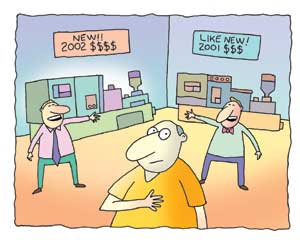August 20, 2002
|
Auction flyers litter the desk of one president of a midsized molding company, speaking volumes about the nearly nonexistent economic recovery in the molding industry. Particularly hard hit are small molding companies that struggle to differentiate themselves, and highly leveraged molding firms.
"Why would I buy new presses when I can get nearly new equipment at fire-sale prices?" he asks.
Why, indeed? Conventional wisdom says used equipment flooding the machinery market has created what some say is a buyer's market for molders, and headaches for makers of new molding machines. In reality, however, the glut of newer, used machinery may be overstated.
Used Machinery: Myth vs. Reality
Richard Stone, a partner in The Machinery Center (Coral Springs, FL), acknowledges that there's a lot of used machinery on the market. However, it's not the "right" machinery. "We've heard about the glut of used injection molding machines," says Stone. "Truth is that while we see many older and somewhat obsolete machines, there is a shortage of later models equipped with current technology."
Stone, who runs The Machinery Center with his partner, Richard Todd, says that he has a client with approval to purchase 10, newer-model molding presses, with the specification that the oldest had to be 1997 or newer, and American built. "Even with the supposed glut of presses on the market, we can't completely fill this order," says Stone.
Todd says that in spite of a shortage of newer, used equipment, business has been good over the past year, primarily due to the service the company provides. "Our ability to sort through the maze of surplus and offer only that which provides true value has given us a unique opportunity to serve our customers," Todd adds. "For this reason, we have a large number of repeat customers."
Real Buyers
Although there are not as many "lookers" as in past years, Stone reports that the level of interest in used equipment has increased dramatically in recent months. "While fewer in number, they tend to be more qualified lookers," Stone adds.
Molders often get an opportunity to buy locally from a company whose owners—and equipmentâ€��”they know well. Fred Stone, president of AIM Processing Inc. (Longmont, CO), recently bought a used 50-ton Boy, formerly owned by Alpine Tooling, a small operation up the road in Boulder. When the owners decided to close the doors, there were four machines available. "One was a Boy they bought new, and they take good care of their equipment," says Stone. "It was the right price at the right time, and in really good condition for an eight-year-old machine, with an early computer-controlled SPC system like on our new Boys."
AIM's last purchase before that was a new Boy machine last year. AIM operates a total of six presses—five Boys and one all-electric from Milacron. Because Fred Stone typically buys new, his representative from Boy contacts him regularly with new-machine deals. "I hear that stuff is going cheap," Stone comments. "There are some bargains out there."
The Machinery Center's Richard Stone notes that it's difficult for Todd and him to evaluate used vs. new machinery simply because they do not sell new. However, they acknowledge that value exists in both at this time. "For some companies that choose to stay on the cutting edge of the latest technology, a used machine won't do, and many older machines—'70s for sure, '80s as well—may never regain their value," says Stone. "For others who recognize the advantage of used equipment, this is a wonderful time to explore options."
Why Buy New?
Despite the increased interest in used equipment, there are pockets of hope among machinery makers. Newell Rubbermaid Inc. recently placed an order for 45 presses from Husky Injection Molding Systems Ltd., making it the largest order in several years for the Bolton, ON, molding machine supplier. After a 40 percent decline in equipment sales in 2001 and a flat first half of this year, the molding industry is hoping for a rebound during the second half of 2002.
Jim Dow, president of Diversified Plastics, purchased two new presses for his custom molding operation in Brooklyn Park, MN. Although the company has purchased used machines in the past, "In this instance, we did not look at used," he says.
"Our feeling is that unless we're very fortunate and can find a used press that meets our criteria, we won't buy used presses," Dow explains. "Quality is a premium, so we need the newest technology available in the market." Diversified now operates 15 presses ranging from 50 to 300 tons.
Dow says that he believes there's a good reason for the glut of older, used machines on the market. "A lot of companies that have gone out of business were cash-strapped, and the machines aren't very well taken care of," he says. "Plus, there are very good deals from new equipment makers."
Richard Stone of The Machinery Center agrees it is a buyer's market, in both new and used machinery. "However, with new machinery builders operating at drastically reduced capacity, a sudden upswing in market demand could easily cause a shortage of new and late-model machinery," he says.
What the future holds for equipment suppliers—both makers of new machinery and used equipment dealers—is anybody's guess. However, Richard Stone is optimistic about a turnaround. "We're very upbeat about the market," he says. "We see some segments that are strong, while others have a long way to go to come back. We believe the shortage of late-model equipment will increase as the overall economy improves. Times are tough, but for the brave at heart, there's never been a better time to buy."
Contact information |
You May Also Like



